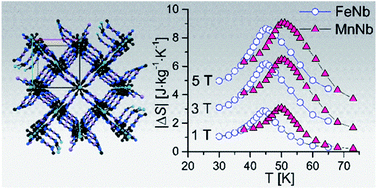A detailed study of the magnetocaloric effect in two isostructural bimetallic compounds {[MII(H2O)2]2[NbIV(CN)8]·4H2O}n (M = Mn, Fe) is presented. The substances show sharp phase transitions to the long-range magnetically ordered state with ferromagnetic coupling between M and Nb sublattices in the case of the Fe-based sample (FeNb, Tc = 43 K) and antiferromagnetic coupling for the Mn-based sample (MnNb, Tc = 50 K). The magnetic entropy change was found to reach 5.07 J mol−1 K−1 (9.09 J kg−1 K−1) for MnNb and 4.82 J mol−1 K−1 (8.65 J kg−1 K−1) for FeNb under the applied magnetic field change of 5 T. Isothermal entropy changes corresponding to different field changes are demonstrated to collapse on a single master curve, which confirms the magnetic transitions in FeNb and MnNb to be of the second order. The results obtained for FeNb and MnNb are discussed in the context of MCE tunability by un/blocking of magnetic connectivity through dis/reconnection of spatially extended ligands.

